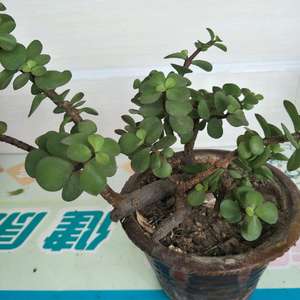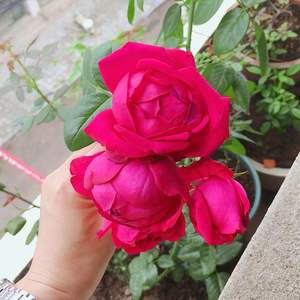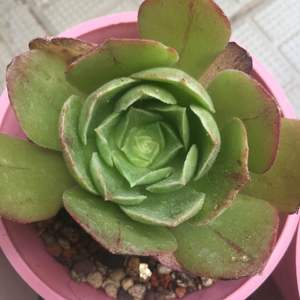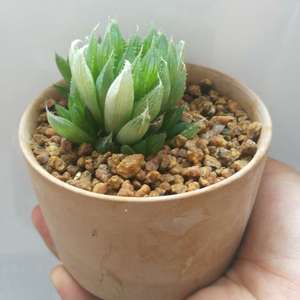文章
Miss Chen
2018年06月26日

Description: This annual plant is about 3-10" tall and more or less erect. It form short side branches along the upper half of the central stem, and sometimes branches along its lower half as well. The stems are light green and pubescent. The middle to upper opposite leaves are lanceolate, oblanceolate, or ovate; they are up to 1¾" long and ½" across. In contrast, the lowermost opposite leaves are linear-oblong; they are about the same length as the other leaves, but more narrow. Both kinds of leaves are light to medium green, hairless, sessile, and dentate or smooth along the margins.
Individual flowers develop from the axils of the upper leaves on pedicels up to 1" long. Each flower has a tubular corolla about 1/3" long and a short tubular calyx with 5 teeth. The front of the corolla is mostly white, while its lower exterior is pale yellow or green with fine veins. The outer rim of the corolla has several spreading lobes that are short and rounded. Inside the corolla, there are 2 fertile stamens, 2 abortive stamens, and a slender style. The exterior of the calyx is green and pubescent; its teeth are slender and often recurved. At the base of each flower, there are a pair of small leafy bracts that are lanceolate or lanceolate-linear in shape. The blooming period can occur from late spring into the fall. While this is a long time period, individual plants usually bloom for only 1-2 months before they die down. Each flower is replaced by a small seed capsule that is ovoid and pointed at its apex; it contains many small seeds. The root system consists of a slender branching taproot. This plant spreads by reseeding itself, and it readily forms colonies at favorable sites.
Cultivation: The preference is full sun to light shade, wet conditions, and exposed muddy soil. Shallow water is tolerated if it is temporary. This opportunistic plant develops very quickly from seed when the ground is wet. It also dies down quickly after its seeds become mature.
Range & Habitat: Clammy Hedge Hyssop is occasional to locally common throughout Illinois, where it is native. Habitats include floodplain forests, muddy depressions in upland woodlands, gravelly seeps, degraded soggy meadows, mud puddles along woodland paths, and poorly drained fields. This little plant likes to colonize disturbed areas.
Faunal Associations: The nectar and pollen of the flowers attract Halictid bees and other small bees. The tiny seeds probably cling to the feet of animals and the shoes of humans as they pass through the muddy areas where this plant grows. Later, these seeds are released into new areas where they may germinate.
Photographic Location: A muddy depression in Busey Woods, Urbana, Illinois.
Comments: This is another small annual in the Figwort family. Unless a large colony happens to be in bloom, it is easy to overlook. Clammy Hedge Hyssop can be distinguished from a similar species, Gratiola virginiana (Round-Fruited Hedge Hyssop), by its pubescent stems and ovoid seed capsules. In contrast, the latter species has succulent glabrous stems and globoid seed capsules. Another small annual in the Figwort family that likes wetland areas, Lindernia dubia (False Pimpernel), lacks pairs of leafy bracts underneath its flowers. Its leaves are usually wider in shape and more shiny than those of Clammy Hedge Hyssop. In spite of the common name, Clammy Hedge Hyssop is not normally found around hedges. This probably refers to the habitat preferences of a European species in this genus.
Individual flowers develop from the axils of the upper leaves on pedicels up to 1" long. Each flower has a tubular corolla about 1/3" long and a short tubular calyx with 5 teeth. The front of the corolla is mostly white, while its lower exterior is pale yellow or green with fine veins. The outer rim of the corolla has several spreading lobes that are short and rounded. Inside the corolla, there are 2 fertile stamens, 2 abortive stamens, and a slender style. The exterior of the calyx is green and pubescent; its teeth are slender and often recurved. At the base of each flower, there are a pair of small leafy bracts that are lanceolate or lanceolate-linear in shape. The blooming period can occur from late spring into the fall. While this is a long time period, individual plants usually bloom for only 1-2 months before they die down. Each flower is replaced by a small seed capsule that is ovoid and pointed at its apex; it contains many small seeds. The root system consists of a slender branching taproot. This plant spreads by reseeding itself, and it readily forms colonies at favorable sites.
Cultivation: The preference is full sun to light shade, wet conditions, and exposed muddy soil. Shallow water is tolerated if it is temporary. This opportunistic plant develops very quickly from seed when the ground is wet. It also dies down quickly after its seeds become mature.
Range & Habitat: Clammy Hedge Hyssop is occasional to locally common throughout Illinois, where it is native. Habitats include floodplain forests, muddy depressions in upland woodlands, gravelly seeps, degraded soggy meadows, mud puddles along woodland paths, and poorly drained fields. This little plant likes to colonize disturbed areas.
Faunal Associations: The nectar and pollen of the flowers attract Halictid bees and other small bees. The tiny seeds probably cling to the feet of animals and the shoes of humans as they pass through the muddy areas where this plant grows. Later, these seeds are released into new areas where they may germinate.
Photographic Location: A muddy depression in Busey Woods, Urbana, Illinois.
Comments: This is another small annual in the Figwort family. Unless a large colony happens to be in bloom, it is easy to overlook. Clammy Hedge Hyssop can be distinguished from a similar species, Gratiola virginiana (Round-Fruited Hedge Hyssop), by its pubescent stems and ovoid seed capsules. In contrast, the latter species has succulent glabrous stems and globoid seed capsules. Another small annual in the Figwort family that likes wetland areas, Lindernia dubia (False Pimpernel), lacks pairs of leafy bracts underneath its flowers. Its leaves are usually wider in shape and more shiny than those of Clammy Hedge Hyssop. In spite of the common name, Clammy Hedge Hyssop is not normally found around hedges. This probably refers to the habitat preferences of a European species in this genus.
0
0
文章
Miss Chen
2018年06月23日


10.Hens and Chicks in an Old Metal Basket
I found this old metal basket in a second hand store. To create this container garden, I soaked moss in water and then squeezed out the excess moisture. I then lined the basket with the damp moss. I then carefully filled the basket with potting soil, making sure not to disturb the moss liner.
Once the basket was filled with soil, I took the hens and chicks out of the nursery pot and broke them up. Planting hens and chicks is incredibly easy, you just need to push them slightly into the soil.
Hens and chicks will thrive in full sun to partial sun and like to be protected from the wind. Water them when the soil dries and fertilize occasionally with a diluted liquid fertilizer. I use a fish emulsion, seaweed combination.
One of the great things about hens and chicks is that the hens, the larger rosettes, multiply rapidly, sending out chicks, smaller rosettes. You can either leave the chicks, or break them off and easily transplant them.

11.Hens and Chicks in a Vintage Tea Cup
I found this tea cup at a yard sale. I carefully drilled a hole in the bottom using a ceramic bit. I then covered the hole with a tiny piece of window screen. I filled the cup with potting soil and tucked the 'purple beauty' and 'red beauty' hens and chicks and houseleeks into the cup, making sure they had contact with the soil and would stay in place.

12.Miniature Succlulent Plant Container Garen
This tiny container garden is only about two inches wide and an inch and a half tall. It is packed with hens and chicks and a couple of echeverias.

13.Purse Garden
I love using purses to make easy hanging gardens. For this one, I bought an evening bag at a second hand store and crammed it full of succulents.
0
0
文章
Miss Chen
2018年06月16日

Description: This herbaceous perennial plant forms a small tuft of ascending to arching basal leaves about 4-12" (10-30 cm.) long. Individual basal leaves are about 1 mm. across, medium green, terete, and hairless (or nearly so). One or two erect floral stalks about 8-16" (20-40 cm.) long develop from the tuft of leaves; these stalks are about 1.5 mm. across, reddish brown, terete, and hairless. The foliage is reportedly aromatic when crushed. Each stalk has a narrow raceme of flowers about 3-10" (7.5-25 cm.) long; these flowers alternate along the stalk and they are sparsely distributed. Each flower is about 2 mm. across, consisting of 3 purplish green petals, 3 purplish green sepals, 3 fertile green pistils that are joined together, and 6 inconspicuous stamens. The outer sepals are orbicular-ovate in shape, while the inner petals have a flattened-pyriform shape. The stigmas of the pistils are white and feathery (plumose).
The slender pedicels of the flowers are 2-10 mm. long, ascending to erect, reddish brown, and hairless. The blooming period occurs during the summer and early autumn, lasting about 1-2 months for a large colony of plants. The flowers are cross-pollinated by the wind. Afterwards, the pistils develop into 3-celled fruits (schizocarps) about 7-9 mm. long and 1 mm. across. These fruits are narrowly oblongoid-oblanceoloid in shape and 3-angled; they are initially green, but later become brown. At maturity, these fruits divide longitudinally into 3 narrow sections, beginning at the bottom. The central axis of each fruit is 3-winged; there are 3 seeds per fruit. The seeds are similar in appearance to their fruits, but a little shorter and more slender. The root system consists of a whitish crown with fibrous roots.

Cultivation: The preference is full sun, wet conditions, and a barren calcareous soil containing an abundance of sand or gravel. This plant is intolerant of competition from other ground vegetation. It is quite cold-hardy.
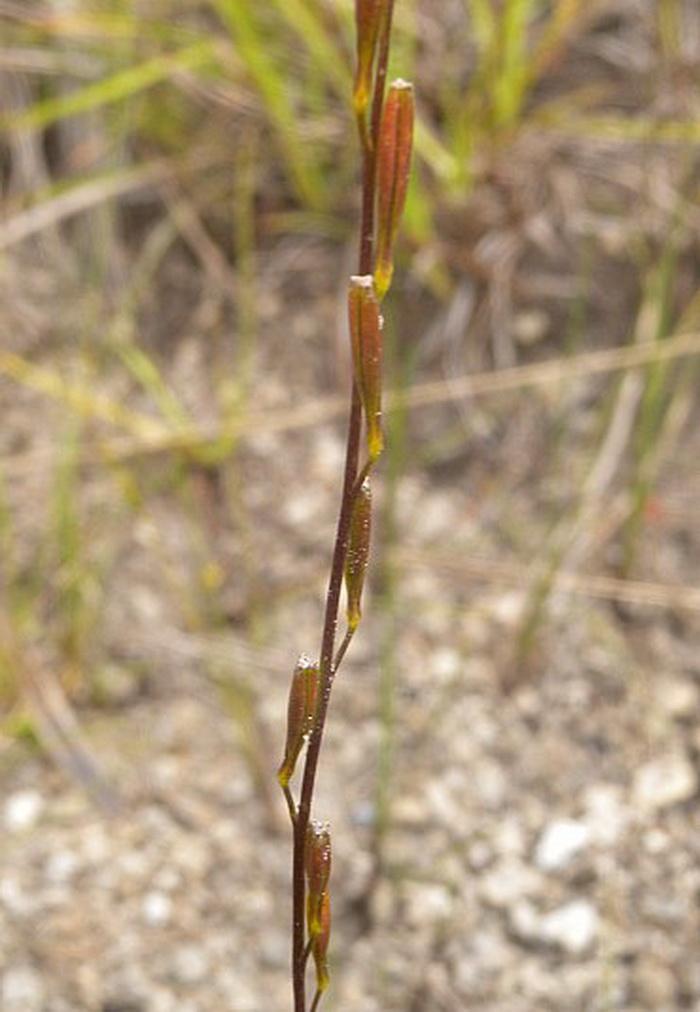
Range & Habitat: The native Slender Arrowgrass (Triglochin palustris) is rare in Illinois, where it is state-listed as 'endangered.' It is found in the NE section of the state and 2 counties toward the center of the state (see Distribution Map). Illinois lies along the southern range-limit of this species. In the United States, Slender Arrowgrass occurs in the New England region, Great Lakes area, Northern Plains, and scattered areas of the western states. It also occurs in Canada, Eurasia, and New Zealand. In Illinois, habitats consist primarily of fens, calcareous gravelly seeps, marl flats, and calcareous sandy pannes near Lake Michigan. This very conservative plant is restricted to high quality natural areas within the state.

Faunal Associations: Floral-faunal relationships of this plant in Illinois are not known. Further to the north in Canada and Alaska, the foliage and especially the whitish crowns are a preferred source of food for the adults and goslings of several species of geese, including Branta canadensis (Canada Goose), Branta bernicula nigricans (Black Brant Goose), and Chen caerulescens (Lesser Snow Goose). The foliage and crowns of Slender Arrowgrass (Triglochin palustris) are reportedly high in protein and low in fiber (Mulder et al., 1996; Prevett et al., 1985).

The foliage also contains hydrocyanic compounds that can be toxic to sheep and cattle if it is consumed in sufficient quantity. There is some evidence in Europe that the seeds of this plant can cling to the fur of deer and cattle. Thus, these animals can spread the seeds to new areas (Mouissie et al., 2005).
Photographic Location: A gravelly seep in McHenry County, Illinois.
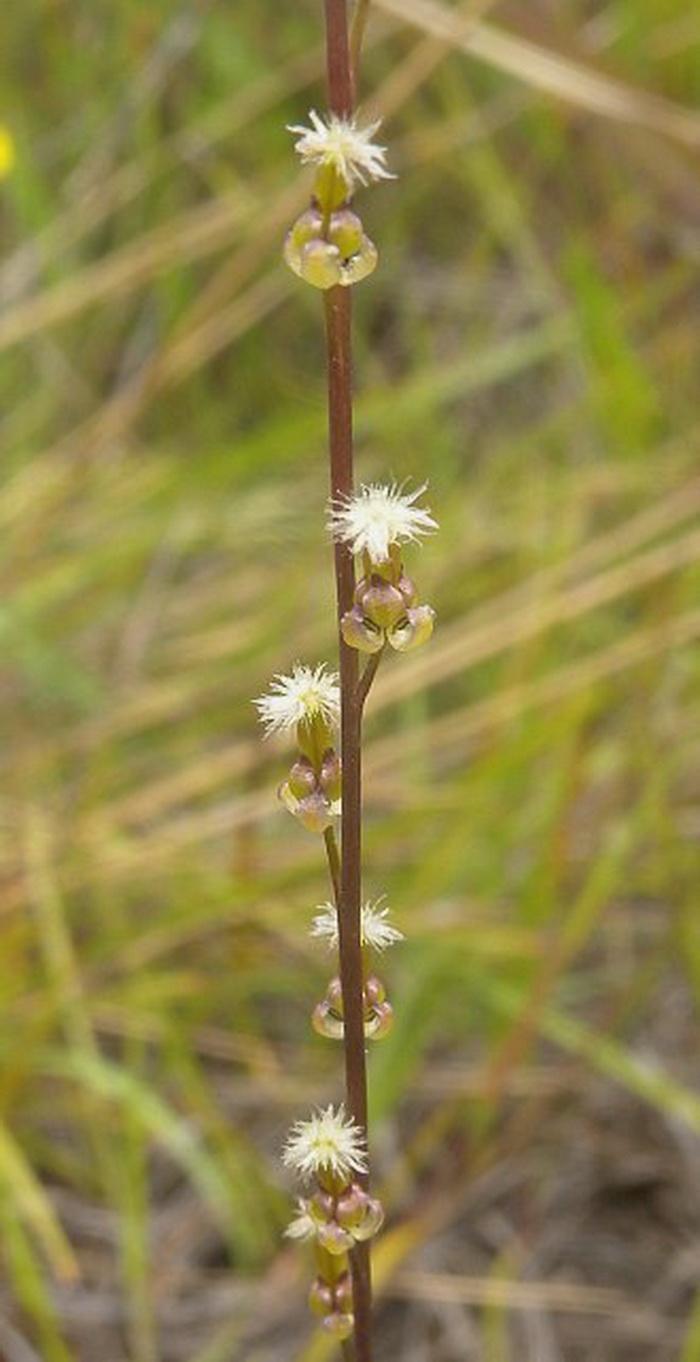
Comments: This plant is not very showy and it is easily overlooked. The only other species of this genus that occurs in Illinois, Sea Arrowgrass (Triglochin maritima), is also very rare within the state and it occurs in similar areas. Sea Arrowgrass is a little larger and stouter than Slender Arrowgrass (Triglochin palustris) overall. Its fruits (schizocarps) have a wider ovoid shape and they divide into 6 sections (6 seeds per fruit), rather than 3 sections. Unlike Slender Arrowgrass, the central axis of its fruit is not winged. The wind-pollinated flowers of these plants are rather odd-looking because their feathery stigmas resemble tufts of hair that are typically found on seeds. An alternative spelling of the scientific name for Slender Arrowgrass is Triglochin palustre, and another common name of this plant is Marsh Arrowgrass.
The slender pedicels of the flowers are 2-10 mm. long, ascending to erect, reddish brown, and hairless. The blooming period occurs during the summer and early autumn, lasting about 1-2 months for a large colony of plants. The flowers are cross-pollinated by the wind. Afterwards, the pistils develop into 3-celled fruits (schizocarps) about 7-9 mm. long and 1 mm. across. These fruits are narrowly oblongoid-oblanceoloid in shape and 3-angled; they are initially green, but later become brown. At maturity, these fruits divide longitudinally into 3 narrow sections, beginning at the bottom. The central axis of each fruit is 3-winged; there are 3 seeds per fruit. The seeds are similar in appearance to their fruits, but a little shorter and more slender. The root system consists of a whitish crown with fibrous roots.

Cultivation: The preference is full sun, wet conditions, and a barren calcareous soil containing an abundance of sand or gravel. This plant is intolerant of competition from other ground vegetation. It is quite cold-hardy.

Range & Habitat: The native Slender Arrowgrass (Triglochin palustris) is rare in Illinois, where it is state-listed as 'endangered.' It is found in the NE section of the state and 2 counties toward the center of the state (see Distribution Map). Illinois lies along the southern range-limit of this species. In the United States, Slender Arrowgrass occurs in the New England region, Great Lakes area, Northern Plains, and scattered areas of the western states. It also occurs in Canada, Eurasia, and New Zealand. In Illinois, habitats consist primarily of fens, calcareous gravelly seeps, marl flats, and calcareous sandy pannes near Lake Michigan. This very conservative plant is restricted to high quality natural areas within the state.

Faunal Associations: Floral-faunal relationships of this plant in Illinois are not known. Further to the north in Canada and Alaska, the foliage and especially the whitish crowns are a preferred source of food for the adults and goslings of several species of geese, including Branta canadensis (Canada Goose), Branta bernicula nigricans (Black Brant Goose), and Chen caerulescens (Lesser Snow Goose). The foliage and crowns of Slender Arrowgrass (Triglochin palustris) are reportedly high in protein and low in fiber (Mulder et al., 1996; Prevett et al., 1985).

The foliage also contains hydrocyanic compounds that can be toxic to sheep and cattle if it is consumed in sufficient quantity. There is some evidence in Europe that the seeds of this plant can cling to the fur of deer and cattle. Thus, these animals can spread the seeds to new areas (Mouissie et al., 2005).
Photographic Location: A gravelly seep in McHenry County, Illinois.

Comments: This plant is not very showy and it is easily overlooked. The only other species of this genus that occurs in Illinois, Sea Arrowgrass (Triglochin maritima), is also very rare within the state and it occurs in similar areas. Sea Arrowgrass is a little larger and stouter than Slender Arrowgrass (Triglochin palustris) overall. Its fruits (schizocarps) have a wider ovoid shape and they divide into 6 sections (6 seeds per fruit), rather than 3 sections. Unlike Slender Arrowgrass, the central axis of its fruit is not winged. The wind-pollinated flowers of these plants are rather odd-looking because their feathery stigmas resemble tufts of hair that are typically found on seeds. An alternative spelling of the scientific name for Slender Arrowgrass is Triglochin palustre, and another common name of this plant is Marsh Arrowgrass.
0
0




